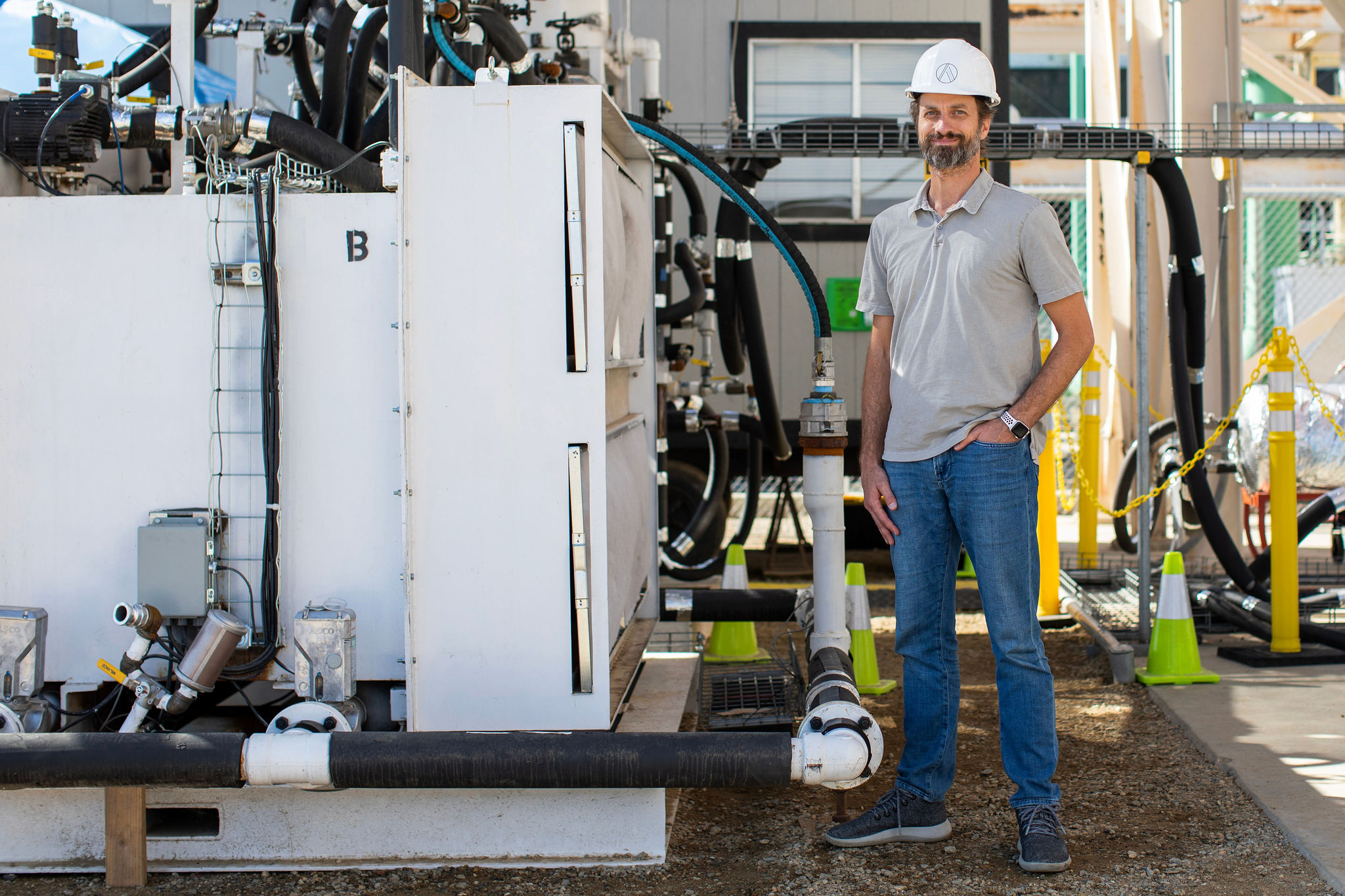
The direct air capture industry is experiencing a technological revolution that's reshaping how companies approach carbon removal. The market is projected to reach $120.8 billion by 2034, growing at a remarkable 61.4% compound annual growth rate.
This explosive growth is being driven by breakthrough innovations, particularly in hybrid systems that are changing the game entirely. What makes this moment so significant isn't just the money flowing in, but the fundamental shift in how these technologies work.
Companies are moving beyond single-method approaches to create integrated systems that capture both carbon dioxide and valuable byproducts simultaneously.
>> RELATED: Resilience and Rethink: Why Hydrogen and Carbon Capture Still Deserve a Seat at the Table

The Hybrid Revolution Changes Everything
The most exciting development in direct air capture is the emergence of hybrid systems that do more than just remove CO2. Avnos, Inc. has made significant strides with its innovative Hybrid Direct Air Capture (HDAC™) technology, which captures both CO2 and water from the atmosphere.
Their first commercial pilot project launched in Bakersfield, California, in November 2023. This dual-purpose approach solves two major challenges that have plagued the industry: high operational costs and limited revenue streams.
Traditional DAC systems were essentially cost centers that only removed carbon. Hybrid systems turn that model upside down by creating multiple value streams from a single operation. The technology works through a sophisticated two-phase process that first extracts water vapor, then captures CO2 from the dehumidified air flow. The captured CO2 can be condensed for transport, storage, or utilization, while the water vapor is converted back into liquid water for reuse or sale.
Market Giants Double Down on Innovation
Climeworks, the global pioneer in Direct Air Capture technology, recently secured $162 million in additional equity funding, marking the largest carbon removal investment of 2025 to date globally. This brings their total funding to over $1 billion, cementing their position as the industry leader.
The Swiss company has achieved remarkable technological improvements with their Generation 3 systems. The new design can capture twice as much CO2 from the atmosphere as the previous version, uses half the energy, and costs half as much overall per ton of CO2 removed.
"Direct Air Capture has gone from experiment to essential—and we're focused on scaling it by driving down costs and pushing innovation. Our hybrid model builds long-term demand while generating cash flow today, helping us grow a market that investors now see as inevitable."
Christoph Gebald, Co-CEO and Co-founder, Climeworks
Other major players are also making significant moves. Key companies include Carbon Engineering ULC from Canada, Global Thermostat from the US, Heirloom Carbon Technologies, and Netherlands-based Skytree. Each is pursuing different technological approaches, from chemical absorption to membrane-based systems.
Four Technologies Competing for Dominance
The DAC market has crystallized around four main technological approaches, each with distinct advantages:
Absorption-Based Systems use chemical or physical processes to bind CO2 from air. These systems excel at large-scale operations but require significant energy inputs for regeneration cycles.
Adsorption-Based Technology employs solid or liquid adsorbents to capture carbon dioxide. This approach offers lower energy requirements but faces challenges with material durability and throughput.
Membrane-Based Capture utilizes specialized polymeric or inorganic membranes to separate CO2 from air. These systems promise compact designs and continuous operation but struggle with selectivity and membrane longevity.
Cryogenic Systems freeze CO2 out of the air using extremely low temperatures. While energy-intensive, they can achieve very high purity levels and integrate well with industrial processes.
Market Scale by the Numbers
- Current Market Size: $0.07 billion (2024)
- 2025 Projection: $0.11 billion (65.9% growth)
- 2029 Target: $0.69 billion
- Long-term Potential: $1.7 billion by 2030
- Ultimate Market Size: $1 trillion by 2050
Beyond Carbon: The Water Connection
What's particularly compelling about hybrid systems is their ability to address water scarcity alongside climate change. In regions facing both high CO2 concentrations and water stress, these systems provide a dual environmental benefit.
The water produced as a byproduct can support local communities, agriculture, or industrial processes. This creates entirely new business models where DAC facilities become multi-revenue operations. Instead of relying solely on carbon credits or removal contracts, companies can sell water, provide cooling services, or even generate electricity through integrated renewable systems.
The scalability potential is enormous. Avnos demonstrated this by showing their HDAC system could scale up to 1000% from its existing version, suggesting that hybrid approaches may overcome the scaling challenges that have limited traditional DAC systems.

>> In Other News: SLB Awarded Carbon Storage Contract for Northern Endurance Partnership Project in UK
Geographic Expansion Accelerates
North America currently leads the direct air capture market, but expansion is happening globally. Iceland has emerged as a major hub due to its abundant geothermal energy and favorable geological conditions for CO2 storage.
The country hosts several major DAC facilities that serve customers worldwide. Companies are strategically positioning facilities in locations with three key attributes: abundant renewable energy, suitable geological storage, and supportive regulatory frameworks.
This geographic diversification reduces operational risks and enables companies to serve global markets more effectively. The international nature of CO2 removal creates interesting opportunities.

“Starting operations of our Mammoth plant is another proof point in Climeworks’ scale-up journey to megaton capacity by 2030 and gigaton by 2050. Constructing multiple real-world plants in rapid sequences makes Climeworks the most deployed carbon removal company with direct air capture at the core.”
Jan Wurzbacher, Co-founder and Co-CEO of Climeworks
Investment Momentum Builds Confidence
The investment landscape tells a compelling story of growing confidence in DAC technology. Climeworks' recent funding round saw participation from BigPoint Holding and Partners Group, with strong backing from existing investors, demonstrating deep confidence in the company's technology leadership and commercial momentum.
This isn't just about one company. The entire sector is attracting serious capital as investors recognize the massive market opportunity. The combination of regulatory pressure, corporate sustainability commitments, and technological breakthroughs has created a perfect storm for investment.
Major corporations are also stepping up as customers. Airlines like SWISS, Lufthansa, and British Airways have secured partnerships with DAC providers, creating demand that extends beyond government programs and voluntary carbon markets.
What This Transformation Means
The shift toward hybrid systems represents more than just technological evolution. It signals the maturation of an industry that's moving from experimental demonstrations to commercially viable operations.
The ability to generate multiple revenue streams while delivering environmental benefits creates a sustainable business model that doesn't depend solely on carbon pricing or government subsidies. For companies evaluating carbon removal strategies, this diversification of DAC technology provides more options and potentially lower costs.
The competition between different approaches will likely drive continued innovation and cost reductions across all technologies. The implications extend beyond climate policy into water security, industrial integration, and regional economic development. As these systems scale up, they could become significant infrastructure assets that support multiple environmental and economic objectives simultaneously.
Subscribe to the newsletter
Daily decarbonization data and news delivered to your inbox
Follow the money flow of climate, technology, and energy investments to uncover new opportunities and jobs.
Companies
Latest issues
-
The Three-Continent Move That Redefines SAF
Wishing everyone a restful holiday season.🎄🎅🎁 Inside this Issue ✈️ Cathay Goes Global With SAF in Three-Continent Fuel Deal 🧪 Proton Ventures Partners With Barents Blue For Realization Of The Bar...
-
Can One Truck Fix Hydrogen’s Biggest Problem?
Inside This Issue 🚛 Alberta's Shared Truck Model Could Crack Hydrogen Adoption ✈️ ZeroAvia Completes Financing Round 🌾 Frontier And NULIFE Scale New Biowaste Carbon Removal Approach 🔥 WAGABOX® Of ...
-
North America’s Carbon Removal Year in Review: Winners, Losers, Surprises
Inside This Issue 🌎 North America's Carbon Removal Year in Review: The Deals, Policies, and Milestones That Shaped 2025 🚢 Hapag-Lloyd And North Sea Container Line Win ZEMBA Second E-Fuel Tender 🪨 ...
Company Announcements
-
ClimeFi Announces New 85,000 Tonne Procurement Round
In its latest procurement round, ClimeFi has enabled more than US$18m in durable carbon removal purchases across eight removal pathways: Biochar, Bioenergy with Carbon Capture and Storage (BECCS), ...
-
Vallourec, a world leader in premium seamless tubular solutions, and Geostock, a global specialist in underground storage of energy, have signed a Memorandum of Understanding (MoU) to strengthen th...
-
CMA CGM, DHL Step Up Ocean Freight Decarbonization with Biofuel Deal
DHL Global Forwarding and shipping group CMA CGM have agreed to jointly use 8,990 metric tons of second-generation biofuel to reduce emissions from ocean freight. The initiative is expected to cut...
-
Next-Generation Gas Turbine Control System For Thermal Power Plants Completes Functional Testing
Integration of Mitsubishi Power's control technology with Mitsubishi Electric's high-speed data processing technology Supports rapid load adjustments and diverse fuels including hydrogen Tokyo, ...
